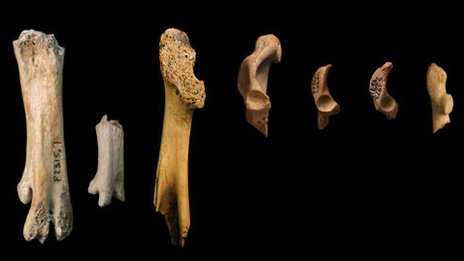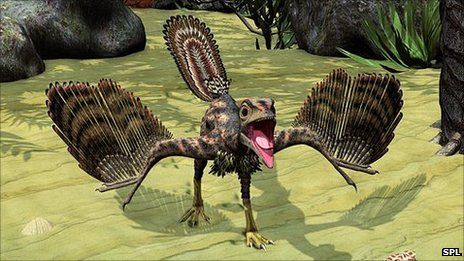
© Nicholas LongrichBird fossils are very rare because the bones are fragile and easily damaged.
Many early bird species suffered from the same catastrophic extinction as the dinosaurs, new research has shown.
The meteorite impact that coincided with the disappearance of the dinosaurs 65 million years ago, also saw a rapid decline in primitive bird species.
Only a few bird groups survived through the mass extinction, from which all modern birds are descended.
Researchers at Yale University have
published their findings in
PNAS this week.
There has been a long standing debate over the fate of the earliest "archaic" birds, which first evolved around 200 million years ago.
Whether their populations declined slowly towards the end of the Cretaceous period, or whether they suffered a sudden mass extinction at the Cretaceous-Tertiary (K-T) boundary is unresolved, owing to conflicting evidence.
DNA studies have attempted to date the origin of modern birds; some suggest that they appeared before the extinction of dinosaurs, with large numbers of them surviving through the extinction event.
But the molecular clock suffers from "method issues", explains Dr Longrich of Yale University, and well-dated fossils are needed for "stratigraphic constraint" of the extinctions.
There are problems with the fossil record however. It is incomplete, owing to the extreme rarity of bird fossils.
Bird bones are very difficult to preserve as fossils as they are small and light, and easily damaged or swept away in rivers.
But the new research, headed by Dr Longrich, has made use of fragmentary bird fossils collected up to 100 years ago, from locations across North America.
New diversityThe fossil deposits, in North and South Dakota and Wyoming in the US, and Saskatchewan in Canada, date from the last 1.5 million years of the Cretaceous period.
More precise dating places the bird fossils to within 300,000 years of the extinction event - a very short period on geological timescales.
These fossils had been studied before, but they have been "shoehorned" into modern groups on the basis of their overall similarity.
Dr Longrich and his team have reanalysed and reclassified these important fossil fragments, using features of the shoulder joint to assign the fossils to modern and ancient groups.

© SPLArchaic birds like Archaeopteryx looked very different to modern ones
The shoulder bone, or "coracoid" is used for classification because it is the most common bone fragment preserved, and it doesn't vary much between individuals of the same species.
Analysing 24 specimens, the researchers identified 17 species, seven of which were "archaic birds" that are not seen after the K-T mass extinction.
These findings show for the first time a diversity of archaic birds alive, right up until the end of the Cretaceous.
This would mean that the archaic birds went extinct abruptly 65 million years ago, and that modern birds must have descended from just a few groups that survived the event.
'Nail in the coffin'Among the primitive species identified, there is considerable variation in size, but there are few other specific adaptations.
Modern birds, on the other hand, have a huge range of adaptations to their particular behaviours or living environments.
This variation would have therefore come about during an explosive evolutionary radiation from the few surviving groups, during the first 10 million years or so following the K-T mass extinction.
"It's similar to what happened with mammals following the age of the dinosaurs." said Dr Longrich.
"Given that the extinction affected mammals, reptiles, insects and plants, it would be remarkable if birds survived the event unscathed," the scientists say in an introduction to their research.
There is growing evidence for the theory that the archaic birds survived until the extinction; more and more bird fossils are being found in Madagascar, Mongolia and Europe.
But these fossils are not well dated, unlike the newly analysed fragments from North America.
Dr Longrich said that this evidence was "a nail in the coffin of the idea of a slow decline".
Reader Comments
to our Newsletter